Day 1 Tashkent ★ Meeting Day
All day
Itinerary Presentation ※ First Impression of Soviet Tashkent
丨Free gathering day
Today is the gathering day. Everyone will take their own flights to Tashkent, the capital of Uzbekistan, and check in at the designated hotel (note: the check-in time for hotels in Uzbekistan is generally after 14:00. Tourists who arrive early can store their luggage and then move freely).
The Republic of Uzbekistan, one of the two doubly landlocked countries in the world, was once an ancient Silk Road country where people from the Han and Tang dynasties visited in an endless stream. It is the country with the richest relics of the glorious history of the thousand-year-old Silk Road.
Tashkent, the capital of Uzbekistan, is the largest city in the five Central Asian countries! The city retains numerous Soviet architectural structures, seemingly frozen in time. It was also a key commercial hub on the ancient Silk Road, where ancient Chinese luminaries such as Zhang Qian, Faxian, and Xuanzang all left their mark.
How to get to Tashkent (Tashkent International Airport, airport code TAS)
There are many flights to Tashkent, including direct or connecting flights from Hangzhou/Beijing/Xi'an/Urumqi/Chengdu.
Booking in advance will get you discounted fares. If you buy connecting flights, make sure there is a certain amount of time between them: usually more than 3 hours, to avoid missing your flight due to delays.


Day 2 Tashkent → Samarkand
·morning
Itinerary Presentation ※ Legend丨Meet the Imperial Capital
After breakfast at the hotel, we'll drive to the legendary city of Samarkand, a city with a history spanning over 2,500 years and a crucial Central Asian hub along the Silk Road. From the ancient kingdom of Kangju to Khwarezm, and then to the capital of the Timurid Empire, Samarkand connects not only east and west but also north and south, making it a shining hub along the Silk Road.
·afternoon
丨A First Look at the Ancient City/Magnificent Tombs and Magnificent Buildings
After lunch we started our tour of the ancient city of Samarkand. The entire ancient city of Samarkand has been listed as a World Cultural Heritage.
First up is the Shah-i-Zinda Mausoleum, a complex of blue tiles that evokes the most beautiful beauty in Central Asia. Shah-i-Zinda, meaning "Eternal King," is one of Samarkand's earliest and most important Islamic mausoleums. Its interwoven patterns of azure, cerulean, and creamy white create a splendid and romantic atmosphere.
We then visited the Hazrat Khizr Mosque, not far away. The original building, built in the 8th century and considered Samarkand's oldest, no longer stands, but it was rebuilt in 1854 and now serves as the mausoleum of the late Karimov, Uzbekistan's first president. Located on Mount Afroshab, it offers panoramic views of Samarkand and the magnificent Bibi Hanem Mosque nearby.
Finally, we'll visit the Registan, Samarkand's most famous landmark. Comprising three madrasas and a plaza, it's known as the "Heart of Samarkand." The majestic and imposing madrasas house a magnificent mosque. Passing through towering archways, we'll find a hall covered in floral patterns and a shimmering golden dome. The walls are clad in varying shades of blue-glazed tiles, with intricate yet regular patterns. Quranic verses are paved in gold, shimmering in the sunlight.
丨Special arrangement/visit to local tile handmade workshop
Hidden deep within Rekistan Square lies a unique tile workshop. Many of Central Asia's most enduring buildings are adorned with a variety of mosaic tiles, with Samarkand being particularly renowned, particularly for its "Shay-Zindar Blue." After admiring so many mausoleums, madrasas, and mosques, you'll undoubtedly be deeply impressed. Therefore, we'll visit a tile workshop to learn more about the local tile-making process and hear the workshop owner share his deep connection with tile. Best of all, you'll also receive a beautiful tile souvenir!


Day 3 Samarkand
·morning
Itinerary Presentation ※ Ancient Monuments丨Treasures of the Timurid Empire
After breakfast at the hotel, we continue our exploration of the ancient city of Samarkand and discover treasures from the Timurid Empire.
First up is the "Stars Above Samarkand" at the Ulugh Beg Observatory, one of the greatest archaeological discoveries of the 20th century. Step inside the observatory and experience the legendary fate of this great man who governed the country while simultaneously delving into astronomy.
Then visit the Afroshaiber Museum, which is the most valuable museum in Samarkand. It displays many cultural relics of Samarkand before Genghis Khan unearthed from the Afroshaiber ruins, as well as many exquisite murals. You will also find many contents from our Tang Dynasty.
·afternoon
In the afternoon we headed to the Gur Amir Mausoleum, the 15th-century mausoleum of Timur and his descendants. The dome is so magnificent it's hard to leave without seeing it.
We then headed to the nearby, lesser-known Aksaray Mausoleum, built in the 15th century and rumored to be the burial site of Timur's great-grandchildren. Its most striking feature is its dazzling golden dome, surpassing even that of Gur Amir.
Afterwards, visit the Bibi Hanem Mosque, considered one of the most magnificent buildings in the East during the Timurid era. Its low-saturation, high-quality blue dome and mosaic walls create a striking beauty that belies its age.
Finally, we walked into Siyob Bazaar, one of the oldest bazaars in Samarkand. The colorful dried fruits, the dazzling array of vegetables, the people talking about business, and the strong local flavor were everywhere.


Day 4 Samarkand → Bukhara
·morning
Itinerary Presentation ※ Glory丨Return to the Middle Ages of One Thousand and One Nights
After breakfast at the hotel, we will drive to Bukhara, the most sacred city in Central Asia and the starting point of the romantic fairy tale of One Thousand and One Nights. This is the birthplace of Alibaba's battle with the Forty Thieves and the starting point of Avanti's battle with Master Bayi. Lonely Planet also praised it with the words: "It is located on a sacred mountain and has buildings that span a thousand years of history."
Upon arrival, have lunch and a brief rest.
·afternoon
In the afternoon we took a stroll to explore the ancient city of Bukhara.
First visit the [Samani Tombs]. The tomb is said to have been built in 905. It is not large in scale but very distinctive. Such a small building can be found in the textbook "History of World Architecture" and its name is also on the list of World Cultural Heritage.
Next, we'll visit the unique exterior of the Porokhoz Mosque, one of Bukhara's most noteworthy buildings. Its uniqueness lies in the 20 massive carved wooden pillars at the entrance. In Uzbekistan, wood is more valuable than stone or brick, and with 20 such tall wooden pillars, even with the erosion of time, the intricate carvings can still be seen.
Finally, we'll visit the Yak Castle, Bukhara's most interesting and oldest historical building. It served as the residence of the Bukhara ruler until 1920. This oldest building in Bukhara features a unique brickwork method, with large expanses of white walls and wooden beams, creating a unique, shabby aesthetic.
Afterward, we'll head to the hotel for the night. We'll stay in a guesthouse within the ancient city of Bukhara, making it easy for everyone to explore the city at any time. However, there are relatively few guesthouses in the city that can accommodate large groups, so accommodations are limited. Please understand!


Day 5 Bukhara
·morning
Itinerary presentation ※ Original appearance丨Experience the original appearance of the ancient Silk Road
When we wake up today, we will enter the romantic fairy tale of One Thousand and One Nights and stroll through the best-preserved ancient city in Uzbekistan - the ancient city of Bukhara, which has almost completely retained its medieval appearance for more than a thousand years.
First up is the Charminar Mosque (Exterior), which graced the cover of Lonely Planet. Built in 1807, it was the gatehouse of a long-gone seminary. Each minaret in the Charminar has a different shape, and its decorative elements are believed to reflect the philosophy of the world's four major religions.
Then, explore the unique Nordil de Vanbo Institute and the statue of Avanti. Built in 1620, this was once the quietest and most interesting part of town. Today, Lébijas remains bustling with people gathering for drinks and conversation, and the square retains its old-world charm.
·afternoon
In the afternoon we continued our exploration of the ancient city of Bukhara.
We went to the Abdulaziz Khan Madrasah, which had hardly been repaired. The tiles inside were severely peeling and it looked very dilapidated, but the reliefs on the arches were magnificent and it was the most beautiful arch among the many Islamic buildings in Bukhara.
Then we come to the Bukhara Ulugh Beg Madrasah opposite, another madrasah left by Ulugh Beg the Great during the Timurid Empire. It was built at the same time as the Ulugh Beg Madrasah in Samarkand's Registan Square and has almost the same structure. They both became templates and became imitation objects for the construction of subsequent madrasahs.
Finally, visit the Kalon Minaret and Mosque, a landmark that even Genghis Khan admired. Dating back to the 15th century, the minaret within the mosque is truly legendary. Completed in 1127, the minaret stands 46.5 meters tall, earning it the title of "Tallest Tower in Central Asia." Untouched by any restoration, the towering structure is constructed from layers of bricks, the beautiful arrangement of which showcases the ancients' extraordinary artistic aesthetic.
Afterward, you'll be free to explore the Dome Bazaar. Located on a strategic Silk Road route, Bukhara boasts a thriving market and flourishing commerce. Traditional markets here, known as Taqi, are domed marketplaces built at central intersections. Three of these markets remain, each retaining its original appearance. The diverse merchandise on offer includes many uniquely Uzbek products, including ceramics by skilled artisans, carpets and silk embroidery by women, and exquisite gold jewelry.


Day 6 Bukhara → Turkish-Uzbek border → Mary
·morning
Itinerary Presentation ※ Bravely Entering the Mysterious Hermit Kingdom
After breakfast at the hotel, we will leave Uzbekistan and cross the Turkmenistan-Uzbek border (the land border crossing procedures are complicated, the management is strict and nucleic acid testing is still required, the whole journey takes about 2-4 hours) to Turkmenistan, known as the "North Korea of Central Asia".
Turkmenistan, a mysterious hermit nation that has secluded itself from the world, has been named "the world's most mysterious and isolated country" by Lonely Planet. With only 12,000 international tourists visiting in 2022, Turkmenistan is sure to be a hidden gem that's never been explored by your friends.
After entering Turkmenistan, we headed south to Mary, the fourth largest city in Turkmenistan. It was once an important stop on the ancient Silk Road and was historically known as "Merv". It is one of the oldest cities in Central Asia and was once the center of several empires.
Note: After entering Turkmenistan, international internet access is restricted and there will be no signal at all! It is recommended to download offline maps, translation software, and necessary information in advance, and report your itinerary to your family.
·afternoon
In the afternoon, we'll visit the ancient city of Merv. Dating back to the 6th century BC, this historic city was once a key city in the Achaemenid Empire of Persia. Over the following millennia, it served as a center for the Parthian Empire, the Sassanid Empire, the Arab Empire, and the Seljuk Empire. During the Seljuk Empire (11th-12th centuries), Merv reached its peak, becoming one of the largest cities in the world and earning the nickname "The Pearl of the Islamic World."
Afterwards, have dinner and check into the hotel to rest.


Day 7 Mary → Ashgabat
·morning
Itinerary Presentation ※ Unveiling the Mysterious Capital of North Korea in Central Asia
After breakfast at the hotel, we set off to drive to Ashgabat, the little-known marble city and the capital of Turkmenistan. The name means "City of Love" in Persian. When you walk into this city, you will find that every building is built with the same material - pure white marble. Under the glory, the whole city is shrouded in a sacred halo, shining brightly, which makes people feel awe.
·afternoon
In the afternoon, we will first visit the Ancient City of Nisa, the earliest capital of the Parthian Empire. It was built in the 2nd century BC by Arsacid I, the founder of the Parthian Empire. It served as the palace for the emperors of the descendants of the founder of the Parthian Empire. The culture here was influenced by the mutual influence of Central Asian and Mediterranean Greco-Roman cultures.
We'll then visit the renowned Akhal-Teke horse farm to see the Akhal-Teke horses. With a history of over 3,000 years, they are one of the world's oldest horse breeds and Turkmenistan's national treasure. Some Akhal-Teke horses are valued at tens of millions of dollars, making them truly rare national treasures. We'll get up close and personal with these remarkable creatures, experiencing their graceful movements.


Day 8 Ashgabat → Gate of Hell
·morning
Itinerary Presentation ※ Extraordinary丨Unforgettable magical giants
After breakfast at the hotel, we will admire a series of magical buildings.
From the outside, you can visit the unique Palace of Happiness, the Alam Indoor Ferris Wheel, known as the world's largest indoor Ferris wheel, the Neutrality Gate, the only symbol of a forever neutral country in Asia, and Independence Square, which houses the Independence Monument and numerous statues of famous figures, symbolizing Turkmenistan's independence and sovereign status.
Then we will go to the luxurious Kipchak Mosque, which is the largest mosque in Central Asia and can accommodate 10,000 pilgrims. It is known as "the symbol of the great spirit of the Turkmen nation."
·afternoon
丨The disappearing miracle/the hellfire burning for half a century
In the afternoon, we'll transfer to an off-road vehicle (3-4 people per vehicle) and head north to the rarely visited Hell's Gate. This breathtaking wonder of the world, nestled amidst the barren desert, presents a vivid spectacle of hellfire: Amidst endless heat waves, a blazing fire erupts from the depths of Hell, burning for over half a century, seemingly eternally. It's also the world's most expensive tourist attraction, costing tens of billions of dollars annually—a truly heartbreaking sight! Over time, the flames at Hell's Gate have dwindled. Our product manager recommends checking in early to see this wonder, as there's a high risk that the last flame will be snuffed out by the wind someday.
Tonight we will enjoy a local barbecue dinner and camp or stay in a yurt nearby to unlock new experiences in your life.
Note 1: We will transfer to an off-road vehicle to Hell's Gate, continuing until Day 9, when we will be dropped off at the border. Each off-road vehicle can accommodate 3-4 people. The road conditions to Hell's Gate are extremely poor and bumpy, so please be aware of this if you are concerned.
Note 2: Tents accommodate two people per room, including sleeping bags and a moisture-proof mat; yurts accommodate three to four people per room. The desert camp is equipped with a public restroom with flush toilets, but showers are not available due to limited facilities. Please understand.
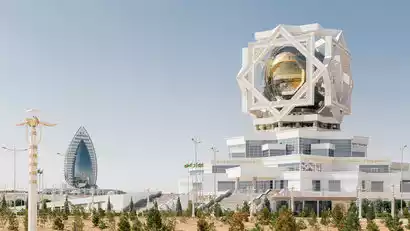
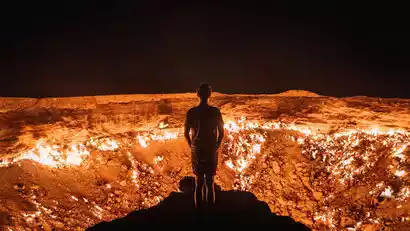
Day 9 Hell's Gate → Turkey-Ukraine Border → Khiva
All day
Itinerary presentation ※ Qianjin丨Stay inside the ancient city of Khiva
Today, you can choose to wake up early and enjoy a sunrise over "Hell." Afterward, bid farewell to Hell's Gate and cross the Turkish-Uzbek border (land crossings are complex and strictly regulated, and the journey takes approximately 2-4 hours) before driving to the ancient city of Khiva.
An old saying circulates along the Amu Darya, Central Asia's longest river: "I would give a bag of gold for just one glimpse of Khiva." What we now call the Old City of Khiva was once the inner city of Khiva, known as Ichan-Kala. It's a nearly intact medieval old town and the first World Heritage Site in Central Asia. Entering this "museum-like city" is like opening an ancient scroll, traveling back in time. The melodious sound of camel bells from the Silk Road echoes through the bustling streets of the city... Millennia of history are imprinted on every brick and tile of this ancient city.
After arriving, we first checked into a homestay inside the ancient city of Khiva to rest, which made it easier for everyone to find the ancient city of Khiva.
Note 1: Hotel resources in the ancient city of Khiva are limited, and local B&Bs and hotels have limited accommodation. Please understand.
Note 2: The roads in the ancient city of Khiva are narrow and buses cannot enter. The hotel will arrange a car to transport your large luggage. Please carry other small items and valuables with you. We will walk to the hotel together and the entire ancient city will be toured on foot.
Then we will go to the Khan Palace Watchtower, which is the best viewing point of the ancient city of Khiva. Let's take a preliminary look at the panoramic view of the entire ancient city!
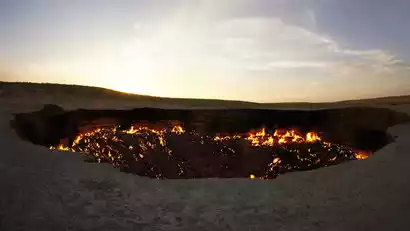
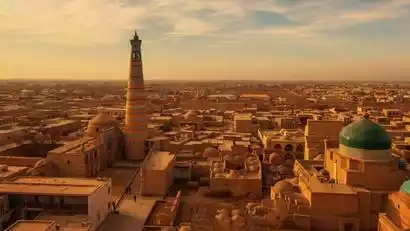
Day 10 Ancient City of Khiva
·morning
Itinerary Presentation ※ Civilization丨Recreate the prosperous scene of the Khwarezmian Empire
The ancient city of Khiva dates back to the 10th century AD, during the heyday of the Khwarezmian Empire. It stands as a unique historical monument, showcasing the civilization and splendor of the Khwarezmian Empire. It has protected the prosperity of the trade routes for millennia and witnessed the continuous fusion of Eastern and Western civilizations.
After breakfast at the hotel, we will go deep into the ancient city to experience the civilization and splendor of the empire in the past.
First, we came to the Carter Minaret. This unfinished minaret, which is now cool when people leave, was built in 1851. Due to years of war, it was originally planned to be the tallest minaret in the world, but it became the most beautiful unfinished minaret. It is the most unique building in the ancient city of Khiva.
Then visit the [Mausoleum of Palavon Mahmud]. Palavon Mahmud is the saint and patron saint of Khiva. Successive Khans of Khiva also hoped to be buried as close to Palavon Mahmud as possible. Today, the mausoleum has become a royal tomb complex, which is also the most magnificent place in the ancient city of Khiva.
Then, we'll visit the Islam Khodja Complex, which includes the Madrasah and a 57-meter-tall minaret. The minaret is the tallest ancient structure in Uzbekistan. Inside the Madrasah is the Museum of Applied Arts, one of the finest museums in the ancient city.
·afternoon
In the afternoon, continue exploring the ancient city of Khiva on foot.
Visit the Juma Mosque, the oldest mosque in the ancient city and a veritable museum of carved wooden columns. Over 200 ancient carved columns bear witness to the artistic inspiration of anonymous artisans. The columns stand in a mystical ensemble, and sunlight filtering through the atrium and interplaying with the wooden columns creates a wondrous play of light and shadow.
Then we came to the most beautiful building near the east gate of Stone Palace. The intricate and delicate carvings on the stone pillars were dazzling.
Next is the Mohammad Rahim Khan Madrasah, which has been transformed into a historical museum on the theme of the Khanate of Khiva, exhibiting photos and textual materials of Mohammad Rahim II and his son Isfandyar.
Finally, visit the Khan Palace, the palace of the Khiva ruler himself, built in the 12th century.
There are many specialty restaurants in and outside the ancient city of Khiva. Today's dinner is at your own expense, so everyone can enjoy it freely.
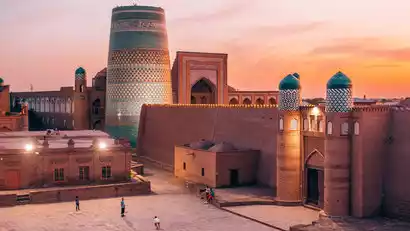
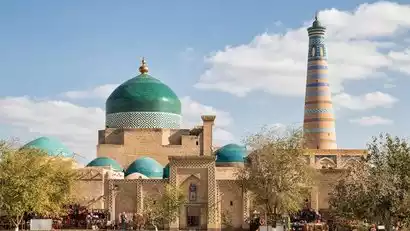
Day 11 Khiva → Urgench → Tashkent ★ Disbanding day (domestic flights to be announced)
All day
Itinerary Presentation ※ Farewell丨Central Asia Chapter Ends
After a packed breakfast, we'll drive from Khiva to Urgench for our domestic flight to Tashkent. Upon arrival, we'll officially disband, marking the end of our two-country Central Asian adventure! Everyone can proceed to the airport on their own, depending on their flight schedule, or continue exploring Tashkent on their own.
Note: Due to the tight domestic flight schedule in Uzbekistan and the unpredictable nature of the situation, in order to ensure your travel, if the flight is fully booked on that day, we may choose to arrive in Tashkent earlier on the previous evening.
丨Instructions for Dissolution Day
Today is the disbanding day. We recommend that you choose a return flight after 16:00. Please also consult the online customer service or product manager (phone and WeChat ID: 15967118126) for a second confirmation before placing an order.








